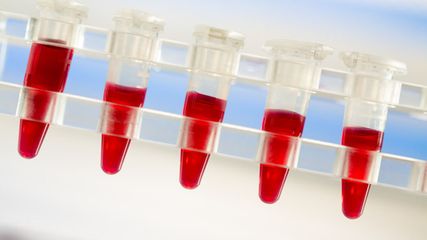
©
Getty Images/iStockphoto
Brentuximab vedotin plus doxorubicin, vinblastine, dacarbazine (A+AVD) in advanced Hodgkin lymphoma – the ECHELON-1 study
Leading Opinions
30
Min. Lesezeit
08.03.2018
Weiterempfehlen
<p class="article-intro">During the plenary session of ASH 2017, Dr Joseph M. Connors presented the primary data from phase III ECHELON-1 study on brentuximab vedotin (BV) plus doxorubicin, vinblastine, dacarbazine (A+AVD) in patients with advanced Hodgkin lymphoma.<sup>1</sup> The combination of doxorubicin, bleomycin, vinblastine, and dacarbazine (ABVD) has been established as the standard of care therapy of advanced Hodgkin lymphoma. ABVD, however, is associated with major toxicities, including myelosuppression and pulmonary toxicities.<sup>2, 3</sup> Since 2003, several studies have attempted to challenge ABVD as the standard of care, but all failed to show a survival advantage with an acceptable safety profile. The ECHELON-1 study is the first randomized phase III clinical trial of a new treatment regimen (A+AVD) that shows improved survival outcomes and manageable toxicities compared with ABVD.<sup>1</sup></p>
<hr />
<p class="article-content"><p>In a previous phase I trial, the addition of brentuximab vedotin, an anti-CD30 antibody,<sup>4–7</sup> to AVD (A+AVD) was well tolerated and showed high response rates; 96 % of the 26 patients achieved a complete response and the 5-year overall survival rate was 100 % .<sup>8, 9</sup> The ECHELON-1 study is the first successful effort in over 30 years to improve clinical outcomes of frontline treatment in advanced Hodgkin lymphoma without escalating the toxicity to unacceptable levels.<sup>1</sup></p> <h2>A+AVD improves overall survival with manageable toxicity profile</h2> <p>The ECHELON-1 study is an open-label, multicentre, randomized, phase III study of A+AVD in patients with newly-diagnosed advanced classical Hodgkin lymphoma.<sup>1</sup> A total of 1334 patients were randomized 1:1 to 6 cycles of either A+AVD (n=664) or ABVD (n=670). The primary endpoint is modified progressionfree survival (by an independent review facility). A modified progression-free survival event was defined as disease progression, death from any cause, or a Deauville score ≥3 followed by subsequent anticancer therapy.<sup>1</sup> The primary data from the ECHELON-1 study have been recently published in the New England Journal of Medicine.<sup>10</sup><br /> After a median follow-up of 24.9 months (range: 0–49.3), treatment with A+AVD significantly prolonged modified progression-free survival compared with ABVD (hazard ratio: 0.77 [95 % CI: 0.60– 0.98; p=0.035]) (Fig. 1).<sup>1</sup> The 2-year modified progression-free survival estimates were 82.1 % (78.7–85.0) and 77.2 % (73.7– 80.4) for the A+AVD and ABVD cohorts, respectively.<sup>1</sup><br /> Interim overall survival, based on 67 deaths, favoured A+AVD versus ABVD (hazard ratio: 0.72 [0.44–1.17; p=0.19).<sup>1</sup> All other remaining secondary endpoints showed a tendency towards improvement in the A+AVD versus ABVD cohort, including complete response at end of randomized regimen (73 % vs. 70 % ; p=0.22), overall response rate at end of randomized regimen (86 % vs. 83 % ; p=0.12), Deauville score of 1–2 after completion of frontline therapy (85 % vs. 80 % ; p=0.03) and Deauville score of 1–3 after cycle 2 (89 % vs. 86 % ; p=0.18)<sup>1</sup><br /> Overall, 121 (18 % ) of patients in the A+AVD cohort and 144 (22 % ) in the ABVD cohort received at least one subsequent anticancer therapy.<sup>1</sup> Thirty-three percent fewer A+AVD patients received subsequent chemotherapy or high-dose chemotherapy plus transplant.<sup>1</sup><br /> Neutropenia and febrile neutropenia of any grade were more common in the A+AVD than in the ABVD cohort (58 % vs. 45 % and 19 % vs. 8 % of patients, respectively).<sup>1</sup> In the two cohorts, prophylaxis with granulocyte-colony stimulating factor (G-CSF) reduced the proportion of patients experiencing neutropenia from 73 % to 35 % and from 57 % to 21 % , febrile neutropenia from 21 % to 11 % and from 8 % to 7 % and grade ≥3 adverse events from 87 % to 57 % and from 67 % to 47 % , respectively.<sup>1</sup> Peripheral neuropathy was increased in the A+AVD cohort (67 % vs. 43 % ); two-thirds of patients in the A+AVD cohort had resolution or improvement of ≥1 grade at the last follow-up visit.<sup>1</sup> In contrast, interstitial lung disease was more frequent and more severe in the ABVD cohort.<sup>1</sup><br /> Fewer deaths were observed in the A+AVD cohort. During the treatment period, 9 (1 % ) patients in the A+AVD cohort and 13 (2 % ) patients in the ABVD cohort died.<sup>1</sup> Nineteen deaths (3 % ) in the A+AVD cohort and 26 deaths (4 % ) in the ABVD cohort were reported during follow-up.<sup>1</sup><br /> In summary, improved modified progression- free survival was achieved in patients receiving A+AVD compared to ABVD. The risk of progression, death or need for subsequent anticancer therapy was reduced by 23 % in the A+AVD cohort.<sup>1</sup> According to Dr Connors, patients were able to take A+AVD safely with preventive measures to improve patient’s blood counts. Dr Connors went on to conclude that «we expect ABVD to cure about three-quarters of patients – which means, of course, that one quarter will not be cured. In this study we’ve been able to significantly reduce that rate of treatment failure. If this new regimen is widely adopted, it will change first-line treatment of advanced Hodgkin lymphoma.»</p> <p><img src="/custom/img/files/files_datafiles_data_Zeitungen_2018_Leading Opinions_Onko_1801_Weblinks_lo_onko_1801_s27_fig1.jpg" alt="" width="2189" height="935" /></p> <p>Imprint: H+O communications Ltd.</p></p>
<p class="article-footer">
<a class="literatur" data-toggle="collapse" href="#collapseLiteratur" aria-expanded="false" aria-controls="collapseLiteratur" >Literatur</a>
<div class="collapse" id="collapseLiteratur">
<p><strong>1</strong> Connors JM et al.: Brentuximab vedotin plus doxorubicin, vinblastine, dacarbazine (A+AVD) as frontline therapy demonstrates superior modified progression-free survival versus ABVD in patients with previously untreated stage III or IV Hodgkin lymphoma (HL): the phase 3 Echelon-1 study. 59<sup>th</sup> American Society of Hematology (ASH) Annual Meeting and Exposition 2017; Atlanta, GA, USA: Oral presentation 6 <strong>2</strong> Vakkalanka B et al.: Neutropenia and neutropenic complications in ABVD chemotherapy for Hodgkin lymphoma. Adv Hematol 2011; 2011: 656013 <strong>3</strong> Martin WG et al.: Bleomycin pulmonary toxicity has a negative impact on the outcome of patients with Hodgkin’s lymphoma. J Clin Oncol 2005; 23(30): 7614-20 <strong>4</strong> Wahl AF et al.: The anti-CD30 monoclonal antibody SGN-30 promotes growth arrest and DNA fragmentation in vitro and affects antitumor activity in models of Hodgkin’s disease. Cancer Res 2002; 62(13): 3736 <strong>5</strong> Francisco JA et al.: cAC10-vcMMAE, an anti-CD30-monomethyl auristatin E conjugate with potent and selective antitumor activity. Blood 2003; 102(4): 1458 <strong>6</strong> Doronina SO et al.: Development of potent monoclonal antibody auristatin conjugates for cancer therapy. Nat Biotechnol 2003; 21: 778 <strong>7</strong> Okeley NM et al.: Intracellular activation of SGN-35, a potent anti- CD30 antibody-drug conjugate. Clin Cancer Res 2010; 16(3): 888 <strong>8</strong> Younes A et al.: Brentuximab vedotin combined with ABVD or AVD for patients with newly diagnosed Hodgkin’s lymphoma: a phase 1, open-label, doseescalation study. Lancet Oncol 2013; 14(13): 1348-56 <strong>9</strong> Connors JM et al.: Five-year follow-up of brentuximab vedotin combined with ABVD or AVD for advanced-stage classical Hodgkin lymphoma. Blood 2017; 130(11): 1375 <strong>10</strong> Connors JM et al.: Brentuximab vedotin with chemotherapy for stage III or IV Hodgkin’s lymphoma. N Engl J Med 2018; 378(4): 331-44</p>
</div>
</p>
Das könnte Sie auch interessieren:
Highlights zu Lymphomen
Assoc.Prof. Dr. Thomas Melchardt, PhD zu diesjährigen Highlights des ASCO und EHA im Bereich der Lymphome, darunter die Ergebnisse der Studien SHINE und ECHELON-1
ASH 2020 – Highlights zu den aggressiven Lymphomen
Highlight-Themen der virtuellen ASH-Jahrestagung im Dezember 2020 waren an erster Stelle die Immunonkologika in all ihren Variationen, aber auch Beispiele für innovative Sequenztherapien ...
Aktualisierte Ergebnisse für Blinatumomab bei neu diagnostizierten Patienten
Die Ergebnisse der D-ALBA-Studie bestätigen die Chemotherapie-freie Induktions- und Konsolidierungsstrategie bei erwachsenen Patienten mit Ph+ ALL. Mit einer 3-jährigen ...


